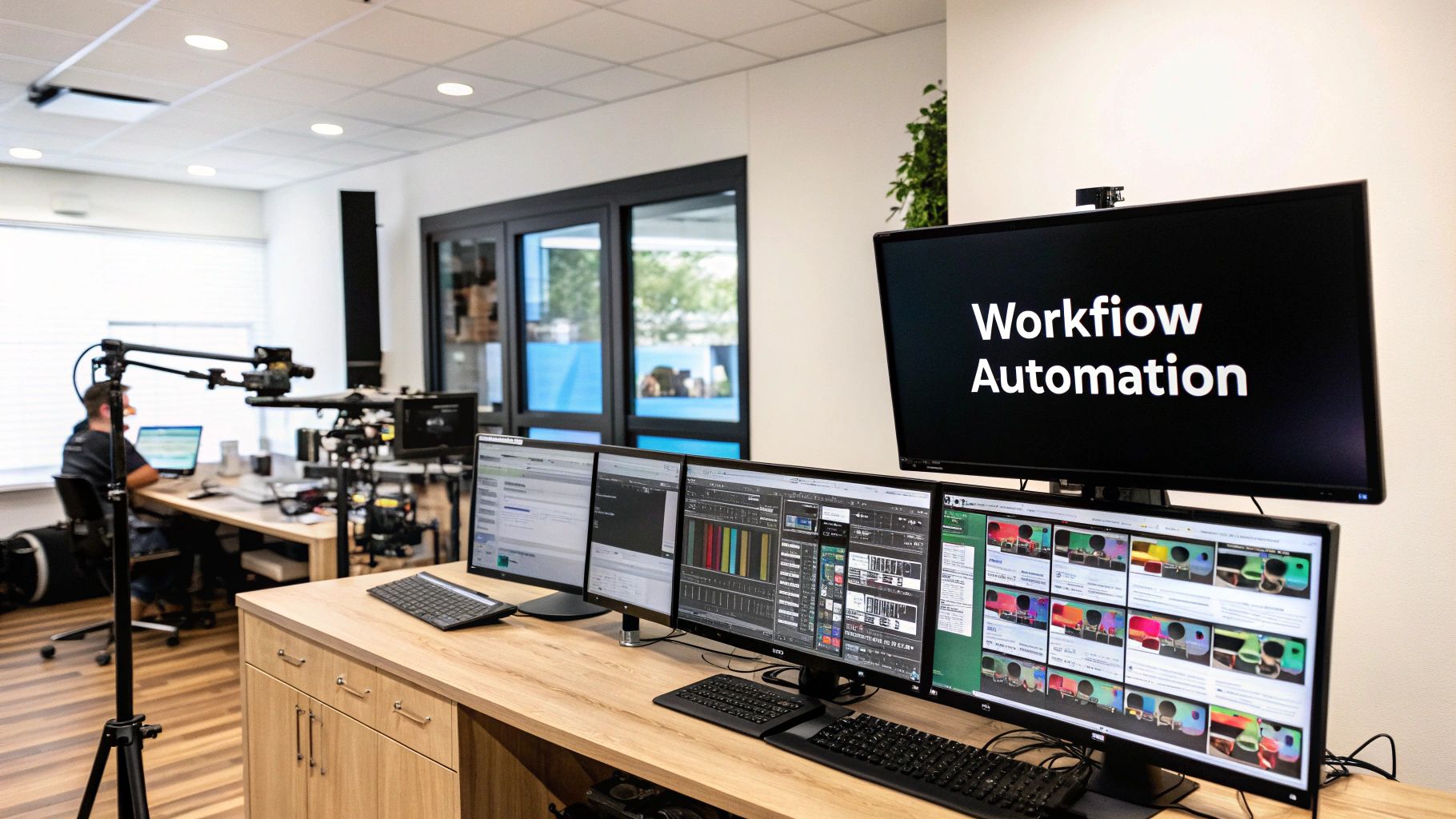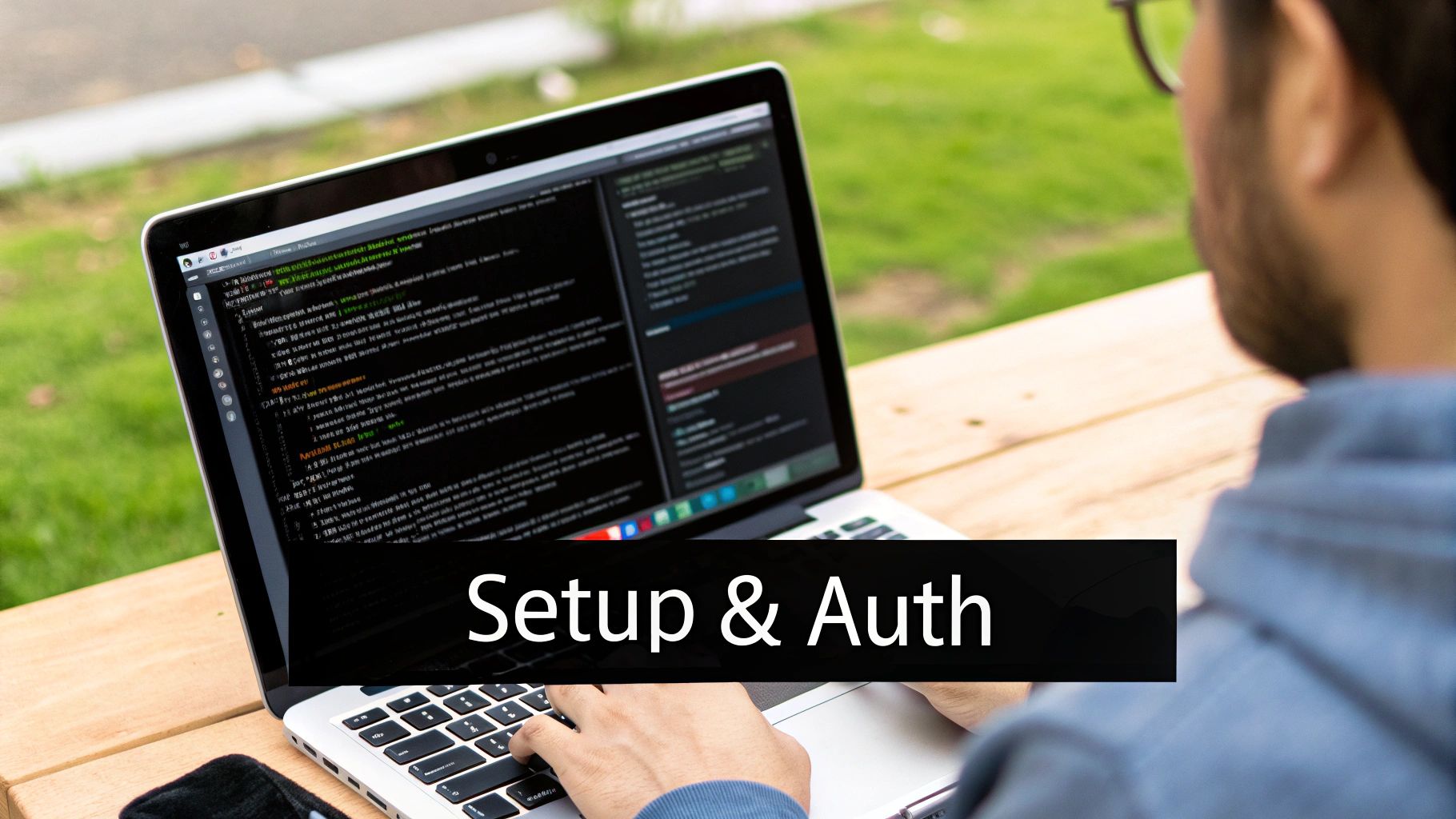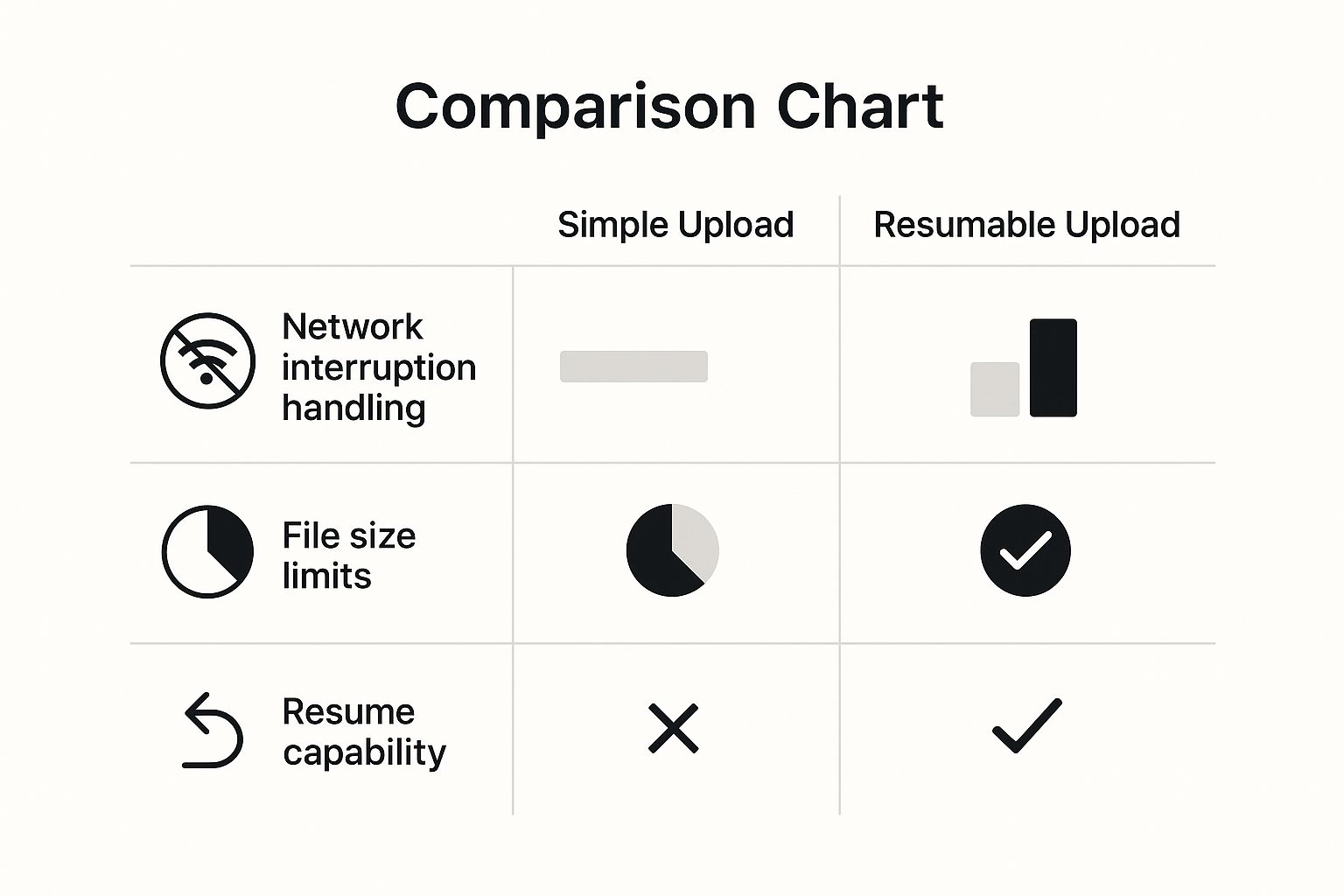If you’re a creator or developer juggling a ton of video content, you know the pain of manual uploads. It's a huge time sink. The YouTube Upload API is your way out, letting you upload videos, tweak metadata, and manage your entire channel programmatically. It's about getting countless hours back.
Why Automate Your YouTube Video Workflow

Seriously, for anyone producing content at scale, the manual upload screen on YouTube is a nightmare. It’s the same repetitive loop of filling out titles, descriptions, and tags for every single video. Not only is it slow, but it's also incredibly easy to make a typo or forget a crucial keyword.
Automating this process cuts out all that noise. You get to focus on what actually matters: making great content.
This is all possible thanks to the YouTube Data API v3, which was built specifically to let third-party apps tap into core YouTube features. It goes way beyond just uploads—you can manage playlists, pull analytics, and much more, all using standard HTTP requests and JSON. If you want to go straight to the source, you can learn more about the YouTube Data API v3 on Google's developer site.
The Core Benefits of API Integration
Once you integrate the API, you'll immediately see how it transforms your content pipeline from a manual slog into a well-oiled machine. The payoff is huge, especially if you're managing more than just a few videos a week.
Let’s take a look at what the API brings to the table.
YouTube Upload API Core Capabilities
| Capability | Description | Primary Benefit |
|---|---|---|
| Bulk Uploads | Upload multiple video files programmatically without user interaction. | Saves massive amounts of time for high-volume creators and media agencies. |
| Metadata Management | Set titles, descriptions, tags, categories, and privacy status via the API. | Ensures brand consistency and improves SEO with standardized metadata. |
| Custom Scheduling | Implement complex, trigger-based publishing schedules beyond YouTube's native UI. | Allows for just-in-time publishing and integration with external calendars. |
| System Integration | Connect your internal tools, like a DAM or CMS, directly to YouTube. | Creates a seamless, end-to-end video production and distribution workflow. |
| Thumbnail Updates | Programmatically set or change a video's custom thumbnail. | Keeps branding fresh and enables A/B testing of thumbnail performance. |
The API isn't just a tool; it's a fundamental shift in how you can manage and scale your video operations.
Here’s a quick rundown of the biggest wins:
- Efficiency at Scale: Imagine uploading hundreds of videos without ever opening the YouTube interface. That's the power you get. It’s a game-changer for media companies and prolific creators.
- Rock-Solid Consistency: You can enforce a metadata template for every single video. Think standardized descriptions, consistent tags, and perfect branding every time.
- Total Scheduling Control: Go beyond the basic "schedule for later" button. You can build custom logic to publish videos based on specific triggers or events.
- Seamless Tool Integration: Hook your video production software or digital asset management (DAM) system directly into your YouTube channel. It creates a smooth, end-to-end workflow.
Automating your uploads isn't just about saving time. It's about building a more reliable, scalable content engine. You achieve a level of precision and consistency that manual work just can't touch.
Setting Up a Dependable System
Building a truly resilient system is more than just whipping up a quick script. It requires a bit of planning. For a fantastic walkthrough on how all the pieces fit together, check out this guide on creating an automatic upload to YouTube workflow.
A well-architected workflow makes sure your videos get published like clockwork, even when you’re not around to hit the button.
Navigating Project Setup And Authentication

Before you can even think about writing code to interact with the youtube upload api, you need to get your hands dirty in the Google Cloud Console. This is the first hurdle where I see a lot of developers stumble, but it’s really just a matter of checking the right boxes. Think of it as getting your official backstage pass before the show starts.
Your first move is to spin up a new project in the Google Cloud Console. This project is your sandbox—a dedicated container for all the API settings, credentials, and usage metrics for your application.
With the project created, you have to tell Google which toy you want to play with. Head over to the API library, find the "YouTube Data API v3," and flip the switch to enable it. This simple click is what gives your app permission to even knock on YouTube's door.
Securing Your Credentials With OAuth 2.0
Alright, with the API enabled, we get to the most critical part: authentication. If your app is going to upload videos on behalf of a user, OAuth 2.0 is non-negotiable. Google requires it to ensure users explicitly grant your app permission to mess with their YouTube account.
The whole OAuth 2.0 dance can seem intimidating, but it breaks down into a few key moves:
- Generate Credentials: Jump into your project's "Credentials" tab and create an "OAuth 2.0 Client ID." If you're building a web app, you'll need to lock down the authorized JavaScript origins and redirect URIs. For a local script, you'll probably just choose the "Desktop app" option.
- Download Your
client_secret.json: This file holds your client ID and client secret. Treat it like the keys to the kingdom—it’s your app's digital identity. - Get User Permission: Your application will bounce the user over to a Google consent screen. This is where they'll see exactly what your app wants to do (e.g., "Manage your YouTube videos") and have to click "Allow."
- The Token Exchange: Once the user agrees, Google sends an authorization code back to your app. Your code's job is to immediately swap this one-time code for two vital pieces of information: an access token and a refresh token.
The access token is your short-term key for making authenticated API requests. The refresh token, on the other hand, is the real prize. It's a long-lived key that lets you get fresh access tokens without forcing the user to log in over and over again. Storing and using this refresh token securely is the secret sauce to any real automation.
The OAuth 2.0 handshake is easily the most complex piece of this initial setup. But nail it once, and your application gains the power to maintain persistent, authorized access to a user's channel, making true automation possible.
Practical Steps For A Smooth Setup
Getting this foundational work right ensures your application respects user security while giving you the keys to automate video uploads. Getting stuck on authentication or project setup can be a massive time-sink, so it pays to be methodical.
For a more hands-on walkthrough of authenticating, building requests, and working with APIs in a real-world context, a good practical API integration tutorial can be a lifesaver. Taking the time to understand these concepts now will save you from countless headaches later on.
Alright, with the authentication sorted out, it's time for the main event: actually getting a video from your computer onto a YouTube channel using the youtube upload api.
This isn't as simple as just firing off a file. The API gives you two different ways to handle uploads, and picking the right one from the start will save you a world of headaches.
The first, and simplest, is a single-request upload. You just bundle up the video file and all its metadata into one big POST request and send it off. It’s quick to code and works just fine for tiny files, say anything under 10MB. Think of it like attaching a small photo to an email—it either works perfectly or fails completely.
But for any video of a respectable size, that approach is a recipe for disaster. If your internet hiccups for even a second, the whole thing dies. You're left with no choice but to start over from scratch. That's where the professional-grade method comes in.
Why Resumable Uploads Are The Professional Standard
The resumable upload protocol is how serious applications move large files across the internet. Instead of trying to push a multi-gigabyte file in one fragile request, you break it down into smaller, more manageable pieces. This makes your script incredibly resilient to the kind of network issues that happen all the time in the real world.
Here’s the basic flow:
- Initiation Request: First, you send a request to YouTube that only contains the video’s metadata—its title, description, tags, and so on.
- Session URI: YouTube responds with a special, unique URL. This is your dedicated endpoint for this one specific upload.
- Chunked Uploads: Now, you start sending the actual video file to that unique URL, but you do it in sequential chunks.
- Status Checks: The magic happens here. If the connection drops, you can simply ask that session URI how many bytes it successfully received. Then, you just pick up right where you left off. No more starting from zero.
For any real-world application, resumable uploads aren't just a nice-to-have; they're essential. They turn a brittle, hope-for-the-best script into a robust tool that can handle flaky Wi-Fi and network interruptions without breaking a sweat.
Crafting The API Request
Putting together the upload request is about more than just pointing to a file. You need to package up all the details that will eventually show up on your video's YouTube page.
This is done with a JSON object called the snippet. Inside it, you’ll define the title, description, and any tags you want to add.
You also need to set the video's privacy level using the status object. This is where you tell YouTube whether the video should be public, private, or unlisted once it’s done processing. Getting this metadata right is a huge part of making your videos discoverable and keeping your channel organized.
The amount of data managed this way is staggering. Just look at a creator like MrBeast. In 2023, his channel data showed over 14.3 billion views across 718 uploaded videos. Every single one of those videos has associated metadata that can be managed programmatically. Developers and researchers tap into this to understand audience behavior at a massive scale. If you're curious about the academic side, you can learn more about social science findings with the YouTube API.
Building a Resilient Upload Process
When you move from a simple script to a production-ready application using the YouTube upload API, "fire-and-forget" just doesn't cut it. Real-world internet is messy. Connections drop, APIs have momentary blips, and things go wrong. A truly resilient process isn't just about making the API call; it's about anticipating failure and engineering your code to recover gracefully.
The secret sauce here is the resumable upload protocol. Think of it as a built-in insurance policy for your uploads. A simple upload is all or nothing—if the connection breaks halfway through, you start over from zero. Resumable uploads, on the other hand, can be paused and picked right back up where they left off. For large video files that can take ages to transfer, this isn't a "nice-to-have," it's a necessity.
Handling Interruptions and Errors
So, how does it work? Instead of sending the whole file at once, you first send an initiation request containing your video's metadata (title, description, etc.). The API responds with a unique session URI, which is basically a dedicated upload endpoint just for your video.
From there, you send your video file in chunks to that specific URL. If your Wi-Fi suddenly gives out or the server times out, it's no big deal. Your application can simply query that same session URI, ask "Hey, how much did you get?", and the API will tell you exactly how many bytes it received. You then just resume sending the rest of the file from that point.
This simple comparison shows just how vital the resumable approach is.

As you can see, for any serious application, resumable is the only way to go. It's the difference between a frustrating, failure-prone tool and a reliable one.
Of course, network drops aren't the only gremlins you'll face. You're bound to run into API error codes. Maybe you'll get a 401 Unauthorized because an OAuth token expired, or a 403 Forbidden after blowing past your daily quota. Good code doesn't crash; it reads these responses and figures out what to do next.
Implementing Exponential Backoff
When you do get an error—especially a server-side one—your first instinct might be to retry immediately. Don't. It's one of the worst things you can do. If the API is already struggling under a heavy load, spamming it with more requests just adds fuel to the fire. You'll make the problem worse and might even get your IP temporarily blocked.
This is where a classic strategy called exponential backoff saves the day. It's a much smarter way to handle retries. The idea is simple: you increase the wait time between each failed attempt. For instance, you might wait 1 second after the first failure, 2 seconds after the second, 4 after the third, and so on. Most implementations also add a small random "jitter" to the wait time to prevent a stampede of clients retrying at the exact same instant.
Implementing exponential backoff is a sign of a well-behaved, professional API client. It shows respect for the service you're using and massively boosts your app's ability to recover from temporary issues all on its own.
This level of resilience engineering—managing resumable uploads, parsing errors, and implementing retry logic—is significant work. It can add considerable complexity and development time to your project. An alternative to building this from the ground up is using a specialized service. Platforms like Late API are designed as an abstraction layer to handle these low-level mechanics, providing a simpler endpoint that manages resilience and error handling for you.
This approach doesn't just make development faster; it also cuts down on the code you have to maintain later. If you're looking to go even deeper on this topic, checking out other strategies to improve API performance can give you more valuable tricks for building fast, dependable integrations. A bulletproof upload process is the bedrock of any video automation workflow that's built to scale.
Below is a quick reference table for some common errors you might encounter with the YouTube API. Having this handy can save you a lot of time when debugging.
Common YouTube API Errors and Solutions
| Error Code | Meaning | Recommended Action |
|---|---|---|
| 401 Unauthorized | The OAuth 2.0 token is invalid or has expired. | Refresh the access token using the refresh token and retry the request. |
| 403 Forbidden | Quota exceeded, or the user has not granted permission. | Check your API console for quota usage. If it's a permission issue, prompt the user to re-authenticate with the correct scopes. |
| 403 forbidden | The request is not authorized to access the requested resource. | Verify that your API key is correct and that the YouTube Data API v3 is enabled in your Google Cloud project. |
| 404 Not Found | The requested resource (e.g., video ID) does not exist. | Double-check the resource ID you are using in your request. |
| 409 Conflict | A resource with the same identifier already exists. | This often happens if you try to create a playlist that already exists. Implement checks to prevent duplicate creations. |
| 500, 503 | Backend server error or service unavailable. | These are transient errors on Google's side. Implement exponential backoff to retry the request after a delay. |
Keep in mind that error responses can sometimes be cryptic, but understanding these common codes will help you build more robust error-handling logic into your application.
Managing Quotas and Tracking Performance

Getting a video uploaded is a huge milestone, but for any real-world application, it's just the beginning. Now we have to think about sustainability, and that means playing by Google's rules.
Every single call you make to the youtube upload api—or any Google API, for that matter—chips away at your daily quota. This isn't just a soft limit; it's a hard cap. Once you're out, your app is dead in the water until the next day.
Understanding the cost of each operation is absolutely critical. A simple read operation, like fetching a video's details, might cost a single 1 quota unit. But uploading a video? That's one of the most expensive actions you can take, setting you back a whopping 1,600 units.
With a default daily quota of 10,000 units, the math is sobering. You get about six video uploads per day before you hit a wall. This constraint forces you to be incredibly strategic about every API call, making sure you aren't burning through precious units on inefficient requests.
Tracking Performance After Upload
Your job isn't done once the upload completes. The real value comes from understanding how your content performs. The YouTube Data API v3 isn't just for uploading; it's also your key to unlocking performance analytics programmatically.
You can pull all the essential metrics for your videos, including:
- View Counts: See exactly how many times your content has been watched.
- Likes and Dislikes: Get a direct pulse on audience sentiment.
- Comment Counts: Measure the level of community engagement and conversation.
By fetching this data, you can build your own custom dashboards or automate performance reports. This gives you a clear, data-driven view of what's working without ever having to manually log into YouTube Studio. It’s the kind of insight that lets you seriously refine your content strategy over time.
Your application's lifecycle doesn't end when the upload hits 100%. Integrating performance tracking and diligent quota management is what separates a simple proof-of-concept from a scalable, professional-grade tool.
Smart Quota Management Strategies
Effectively managing your API quota is a non-negotiable skill. For a much deeper dive into the nitty-gritty, our guide on calculating YouTube API limits and costs is an essential read.
Over the years, Google has added more powerful features to its analytics tools. For instance, a 2017 update introduced the include-historical-channel-data parameter, which was a game-changer. It allowed developers to fetch performance data from before a channel was linked to their app, providing a much richer historical context. You can explore more about the API's revision history to see how it’s evolved.
As your application scales and you find yourself consistently bumping against the limits, you can request a quota increase from Google. Just be prepared to justify it with a solid use case that demonstrates efficient and responsible API usage.
Considering an Alternative: The Late API
While the native youtube upload api is a beast, taming it can feel like a full-time engineering project. You have to wrestle with an intricate OAuth 2.0 flow, keep a close eye on strict quotas, and build out resilient error handling from scratch. For any team that needs to ship features fast, this can become a serious bottleneck.
This is exactly the kind of friction a specialized tool like Late API is built to eliminate. It acts as a smart abstraction layer, taking care of all the messy, low-level mechanics of YouTube's API so you don't have to. Instead of fighting with refresh tokens and implementing exponential backoff, you get a clean, simple endpoint for all your video uploads.
How Late API Streamlines the Upload Process
The real magic of using an alternative like Late API is just how much complexity it strips away. It completely handles the OAuth 2.0 authentication dance and the entire resumable upload protocol. What would normally take dozens of lines of code to manage tokens, handle network hiccups, and retry failed chunks is boiled down to a single, straightforward API call.
This approach pays off immediately in a few key ways:
- Lightning-Fast Integration: You can get a video upload workflow up and running in minutes, not days or weeks. Less code to write means less code to test and maintain.
- Built-in Resilience: Late API automatically manages resumable uploads and intelligent error retries out of the box. This ensures your video transfers are rock-solid against network issues, with zero extra effort on your end.
- Simplified Quota Management: By optimizing how requests are made, Late API helps you get the most out of your daily YouTube quota and avoid those dreaded service interruptions.
Most developers want to get video content published, not become experts on the intricate details of Google's API infrastructure. A service like Late API offloads that burden, letting you stay focused on your app's core features.
A Practical Comparison
Picture this: you need to upload a 500MB video file.
Using the native API directly, you’d be responsible for implementing the entire resumable protocol. That means managing the upload state, handling any 4xx/5xx errors that pop up, and coding all the retry logic with exponential backoff. It's a non-trivial engineering task that can easily burn through significant development hours.
With Late API, that entire sequence is reduced to one API request. You hit the endpoint, and the platform handles the rest, guaranteeing the video gets delivered reliably to YouTube. This is precisely why so many developers are seeking out a YouTube API alternative that puts speed and simplicity first.
It enables rapid development and helps you build scalable video applications without the long-term maintenance headache of a custom-built integration. If you're on a tight deadline or your team doesn't have deep API expertise, this can be a massive accelerator.
Ready to stop wrestling with complex API integrations? Late provides a single, unified API to schedule and publish content across 10+ social platforms, including YouTube. Cut your development time from months to minutes and build reliable social media features with an API trusted by over 2,000 developers. Explore the Late API and start building for free.